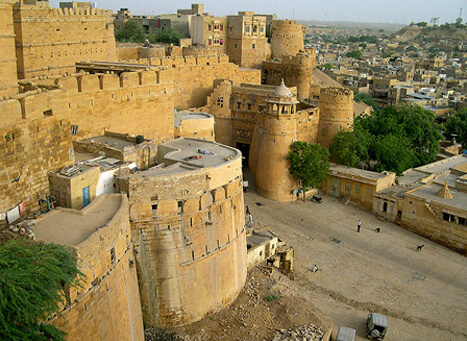Jaisalmer Fort Architecture Significance nestled amidst the vast golden dunes of Rajasthan lies the shimmering Jaisalmer Fort. This majestic fortification is more than just a marvel of architecture; it’s a living testament to India’s rich tapestry of history, culture, and artistic excellence. Each brick and stone, every arch and balcony, tells tales of bygone eras, brave rulers, fierce battles, and the timeless spirit of a civilization. As we embark on this enlightening journey, we aim to immerse you in the intricacies and marvels of this fort, painting a vivid picture of its significance in the annals of history.
A Brief Overview of Jaisalmer Fort
The Glorious Past
Jaisalmer Fort, fondly known as “Sonar Quila” or the Golden Fort, is a masterpiece that has stood the test of time. Constructed in 1156 AD by the Rajput ruler Rawal Jaisal, from whom the city derives its name, this fort has witnessed countless battles, endured natural calamities, and seen kingdoms rise and fall.
The Strategic Location
Located strategically on the ancient Silk Road, it has been a significant trading center, connecting India to Central Asia. Can you imagine the kind of stories its walls would tell if they could speak?
The Enchanting Architecture of Jaisalmer Fort
The Unique Foundation
Built on the Trikuta Hill, the fort is made of yellow sandstone, which magically transforms into a honey-gold hue as the sun sets. It’s almost as if the fort itself is a sun, radiating its golden glow.
Intricate Designs and Craftsmanship
The fort’s architecture is a blend of Rajput and Islamic styles. We often find ourselves mesmerised by the ornate jharokhas (balconies), chhatris (pavilions), and jaalis (lattice screens). Have you ever seen such a fusion where beauty meets function?
The Fort’s Layout
Within its walls, the fort houses numerous palaces, temples, and residential buildings. It’s a living fort, where a quarter of the city’s population still resides.
The Defensive Structure
Built with three layers of walls, the fort was constructed with defense as a priority. The outer and inner walls are made of solid stone blocks, while the middle wall is filled with rubble. This design was instrumental in thwarting many enemy invasions.
Jaisalmer Fort’s Role in History
A Witness to Warfare
Over centuries, the fort has seen many battles. Jaisalmer Fort Architecture Significance .It was a symbol of power and strength, and its possession meant dominance in the region.
An Emblem of Cultural Exchange
Because the fort sat right on the Silk Road, it became this amazing mix of cultures, traditions, and arts. Can you imagine? One place showing you a glimpse of so many different worlds.
Protecting the Legacy
Historic sites like the Jaisalmer Fort aren’t just relics of the past; they are windows to our cultural and historical roots. The fort, with its mesmerizing beauty and tales of yore, deserves protection and reverence. Recognized as a UNESCO World Heritage Site, it already garners attention on a global scale for conservation. Dedicated organizations and local authorities work hand in hand, undertaking measures to ensure the fort’s structural integrity, preserving its ancient artworks, and maintaining its surroundings. Furthermore, awareness campaigns educate visitors about the fort’s importance, urging them to tread lightly and responsibly. These combined efforts aim not just to preserve a monument, but to safeguard a tangible piece of history for generations to come.
How Can We Contribute?
Visiting the fort, understanding its significance, and respecting its boundaries are small steps we can take. After all, it’s not just a monument; it’s a legacy.
Conclusion
Jaisalmer Fort is not just a structure; it’s an embodiment of tales, traditions, and tenacity. Its golden walls seem to shimmer and tell stories of ancient times, of kings and queens, of art and culture, and the indomitable spirit of its people. Walking through its many passageways, peeking into hidden corners, and listening to its stories, it’s evident that Jaisalmer Fort is not just an old structure. It feels alive, almost like it’s whispering secrets from the past, and stands proud, reminding us of its timeless legacy. It beckons every history enthusiast, every wanderer, and every dreamer to come, explore, and be enchanted by its everlasting charm.
FAQs
1.When the Jaisalmer Fort built?
It constructed in 1156 AD.
2.Why Jaisalmer Fort known as the Golden Fort?
It made of yellow sandstone that shines like gold during sunset.
3.How can one contribute to the fort’s preservation?
By visiting, understanding its significance, and respecting its boundaries.
4.The fort still inhabited?
Yes, a significant portion of the city’s population still resides within its walls.
5.What architectural styles are reflected in the fort?
It showcases a blend of Rajput and Islamic architectural styles.

